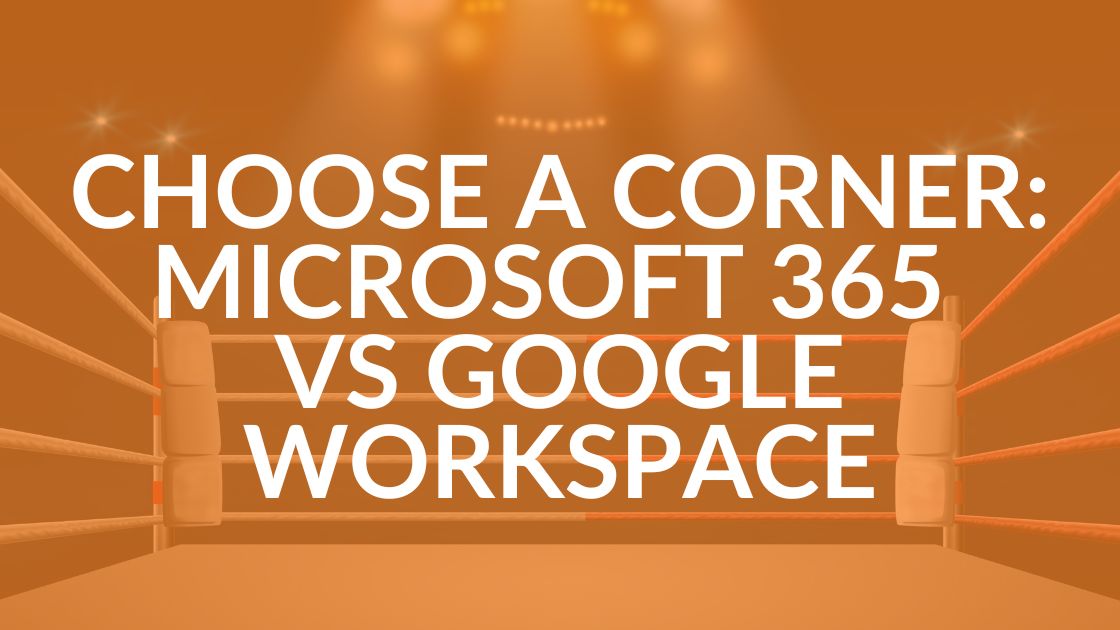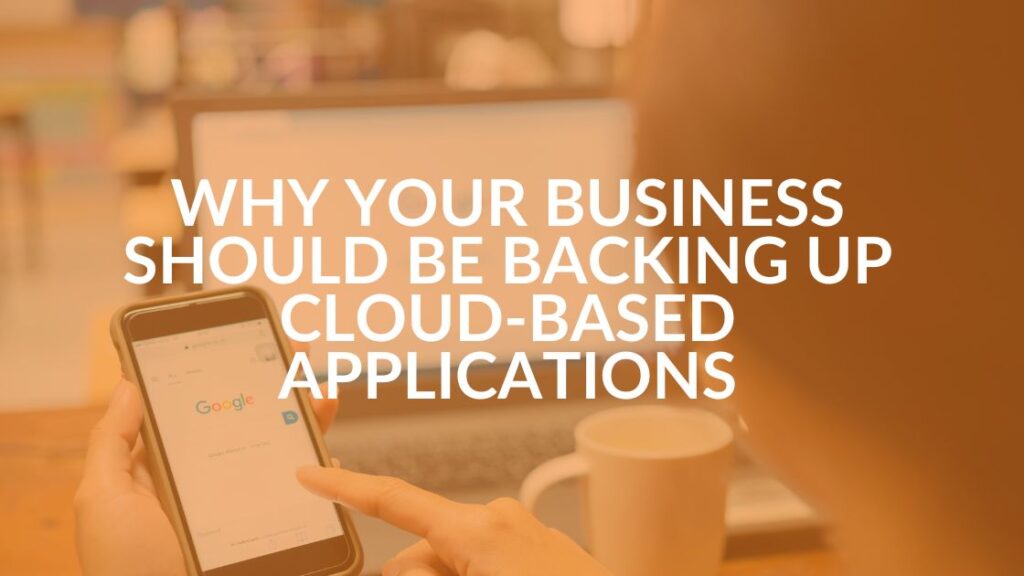Microsoft 365 vs Google Workspace: Which Is Right For Your Organization?

Who wins the Microsoft 365 vs Google Workspace smackdown? Like many other decisions, the answer depends … on the size of your organization, the type of industry, budget and, of course, your personal preferences. Here are some considerations to help you decide which cloud platform may work better for your organization.
Before we dive in, it is important to note that both these products have changed names a few times. Microsoft 365 was called Office 365 or Microsoft Office 365. Google Workspace was once Google Suite and Google Apps.
Portability and Collaboration Differences
Microsoft 365 and Google Workspace are both cloud based platforms that support common business tasks and they allow team members to collaborate and work in files at the same time from a web browser. Some of these tasks include:
- Calendaring
- Creating and editing documents, spreadsheets and presentations
- File sharing and management
- Collaboration
- Voice and video conferencing
- Chat
However, Microsoft also has desktop versions of their popular Office applications (programs can also be installed on individual computers) so you can create and work on files locally on your devices as well as in the cloud. Google Workspace does not.
Microsoft’s OneDrive cloud allows you to sync files between your devices and the cloud so that they are always available and current. These files (Word docs, Excel docs, images, PowerPoint and Publisher files, etc.) are all easily available to download fairly quickly to work on. When you close them they will automatically be updated to the cloud.
Google Drive also allows you to sync files automatically, but you first need to choose the files you want to sync and the files don’t actually download to your desktop until you click on the file’s name. This limits the amount of space needed on your device to sync and takes less time, since only one file syncs instead of them all. But if you know you need to work often on a lot of downloaded files, the individual process can be tedious.
Pricing Differences and Scalability
Both have reasonable basic plans of $6 per user per month. But what you get for that investment is different, especially when it comes to storage size and scalability.
| Microsoft 365 | ||
|---|---|---|
| Storage | 1TB + 50GB dedicated email inbox Includes its most popular web apps: Word, Excel, Teams, Outlook (emails and calendar), OneDrive, SharePoint, and PowerPoint If you also want desktop versions of the apps listed above, you’ll need to subscribe to the “Apps for Business” plan, which is $8.25/user/month | 30 GBtotal for apps and emails Includes Gmail, Slides, Drive, Meet, Calendar, Chat, Sheets, Slides, Keep, Chat, Sites, Forms If 30 GB doesn’t cover your needs because, for example, your organization relies heavily on images, you would have to move up to Google’s Business Standard Plan which is $12 per user per month and gives you 2TB. |
| Scalability | You can increase your storage by user, if needed. | Requires you to increase the data for all your users, which can be quite costly. In general, however, storage increments are less expensive for Workspace. |
While Google Workspace plans are pretty straightforward, there is a lot more nuance (and flexibility) to the Microsoft 365 pricing. If Microsoft is the best fit for you, it may be helpful to work with a managed service provider to ensure you are maximizing productivity and security and minimizing cost.
Email in Microsoft 365 vs Google Workspace
Technically, you can use any email program, but people commonly stay with the default apps: Outlook for Microsoft 365 and Gmail for Google Workspace.
- Both have good email search functions.
- Microsoft has traditional folders for email organization while Google relies on tag-based organization, which can be hard to adapt to if your team is used to Outlook-like email folders. The desktop version of Outlook is far superior to Gmail when it comes to how you group, label and sort email.
- Microsoft automatically prioritizes your emails into “Focused” and “Other.” It sorts them based on your usage to those email addresses. Google does not.
Video Conferencing in Microsoft 365 vs Google Workspace
Microsoft is quite generous with its video conferencing quota. With its Team business plans, it allows 300 participants and some plans allow up to 1,000 with up to 20,000 “viewers.”
Google’s Meet allows only 100 on its starter plan upward to 500 on its business plus plan. This might not make a difference to small businesses that are unlikely to ever need a large attendance for video conferencing, but it’s good to know in case you do.
4 Reasons to Choose Microsoft 365 Over Google Workspace
- Desktop apps (in addition to cloud)
- Sophisticated, feature-rich apps that are the worldwide standard
- Video conferencing capacity
- Initial storage capacity and flexibility for scaling
4 Reasons to Choose Google Workspace
- Less complex and feature rich, which means it is easier to deploy, maintain and support
- Can be used to edit Google Workspace and Microsoft Office documents
- Built for collaboration from the ground up
- Encourages cloud-based working (because offline isn’t as easy or accessible)
Shared Responsibility Model
With either Microsoft 365 or Google Workspace, it’s important to understand the shared responsibility model of the cloud. TechTarget describes is as “When an organization moves to a public cloud computing model, it hands off some, but not all, of these IT security responsibilities to its cloud provider. Each party — the cloud provider and cloud user — is accountable for different aspects of security and must work together to ensure full coverage.” They have an excellent infographic that can clear up common misconceptions about who is responsible for security to help ensure that your cloud platform stays secure.
The Bottom Line: Microsoft 365 vs Google Workspace
Both are great platforms with specific pros and cons. At Intrust IT, we consider Microsoft 365 the clear winner for businesses larger than a few employees or those that are in a growth mode. Microsoft 365 is more flexible, scalable and has a full suite of apps and solutions so you can take care of all your business documentation and collaboration needs within one platform.
That said, most small to mid sized businesses would benefit from the expertise of a managed service provider (MSP) to maximize their Microsoft 365 licenses and configuration — and to ensure that platform is configured for security.
If you’re already using Microsoft 365 our dedicated team of cybersecurity experts can help you review your MS Secure Score and apply our list of 21 Microsoft 365 controls to ensure that you are secure and productive.
Contact us or book a meeting to talk through your business IT needs with our experts today.
Share this Blog

Is Your Name or Birthday a Part of Your Password?
If so, you’re a part of the 59 percent of people who don’t follow proper password hygiene. More than 70 percent of passwords are used for more than one system, meaning if cybercriminals crack one, they can access a lot more accounts.
Our free Enterprise Password Management Guide will give you the best password hygiene practices to help you secure your computer and your business.
Download the Guide
Explore the Latest Trends in IT

Microsoft 365 and Google Workspace: The Importance of Backing Up Your Cloud-Based Applications

AI Guiding Principles

Edge vs Chrome Security: Which Is the Best Browser for Your Business?




